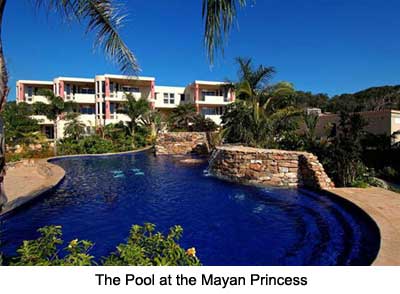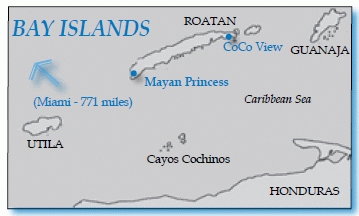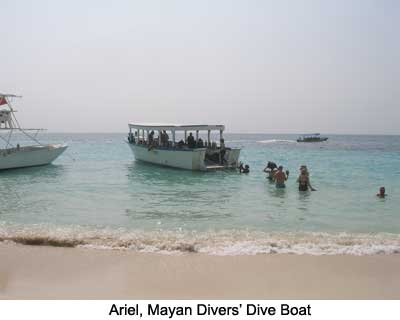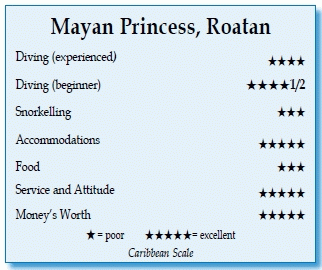Mayan Princess, Roatan, HondurasContents of this Issue: Mayan Princess, Roatan, Honduras Cancun, Cabo San Lucas, Fiji, Truk. . . Give Your Buddies a Free Undercurrent Subscription Improving Rebreather Safety: Part I Widow Blames Dive Gear for Death of Filmmaker Parents of Drowned Boy Sues PADI and Boy Scouts Editorial Office: Ben Davison Publisher and Editor Undercurrent 3020 Bridgeway, Suite 102 Sausalito, CA 94965 Disney-like digs and aquarium-like diving from the August, 2012 issue of Undercurrent
Dear Fellow Diver: The last time I went to Roatan's beloved CoCoView Resort, I became intrigued by the proverbial "other side of the mountain," where I discovered the town of West End, a sleepy, hot, mysterious admixture of folk art, vegetables sold off pickup trucks, dive shops, dirt roads and a beautiful beach. When my local dive shop advertised a trip to the Mayan Princess on Roatan's West Bay Beach, a couple miles and a world away from the town of West End, I jumped. While preferring more rustic, diveronly retreats like Pirate's Point on Little Cayman, I was intrigued by the Disney World façade, a splendor unknown to these parts -- and a very good price -- though little did I know that the kitchen would fail to escape certain Third World qualities.
Surfacing after 66 minutes for a first dive in the 79-degree water, I had swum with the usual Caribbean suspects, though not in great numbers: grunts, hamlet, parrotfish, butterfly fish, schoolmasters, a gang of Caribbean lobsters, snapper, a juvenile spotted drum and iridescent azure vase sponges. With water that ranged from 75- to 100-foot visibility, I came upon a cluster of juvenile sunshinefish with gold upper bodies and purple lower halves. Spotting a rare solitary gorgonian hydroid -- resembling a tiny, white, carnivorous sundew plant -- satisfied my "when in Roatan, look for macro" quest within the first 30 minutes. Here, in the protected Roatan Marine Park, I saw a toothy tiger grouper and a yellowfin grouper on the first dive. On my second dive that morning, I spotted my first lionfish of the trip. I left my gear on board to head to a lunch amounting to the equivalent of a full dinner. My buffet plate was soon covered with a medley of carrots, onions and green beans, potatoes provencal, beef tips and pepper slices, and pork with rich pancetta gravy. For dessert, a small slice of cinnamon swirl cake, topped with a creamy coffee-laced icing, filled the bill. In this setting, the phrase "portion control" was a hedonistic double entendre.
After a day of diving, it was pleasant to decompress in my second-story, air-conditioned junior suite overlooking the lush, tree-lined courtyard and pool. My 500-square-foot condo included a roomy bedroom with queen bed, flatscreen TV and ceiling fan. The bathroom offered a walk-in shower screened by glass blocks. The large living room led to a balcony, washed by breezes from its own ceiling fan, that held a gas barbeque grill, table and chairs. With no balcony pegs outside for hanging dive gear, wetsuits soon festooned railings; probably a trashy sight to some tourists, but not to us serious divers. That night, my spouse and I enjoyed complementary sundowners while people- watching on the beach as the sun set. The resort hosted a different bar band every night in its beachside bar. Later, a talented troupe of young dancers in traditional garb performed to the hypnotic accompaniment of bongo and conga drums. After sampling some rum drink not worth finishing, I settled on the fruity, whiskey-based "Mayan Princess." Local lagers like Salva Vida were on the all-inclusive bar menu, but not wine. That was a source of minor irritation for my spouse, who reconnoitered the area and came up with a reasonably-priced red wine from the shopping district a block off the beach. The next day offered variations on the Caribbean reef tableau I had seen the day before: trumpetfish, hawkfish, chromis, a spotted moray, goldentail moray and tiger tail sea cucumber. Most meaningful was sprouting staghorn coral, one displaying opened polyps. Inside tiny white cups, fine brown wispy filaments protruded. The marine park offers a great environment for staghorn rejuvenation. Judging by the number of sea turtles on most dives, they liked the park, too.
For repeat Caribbean divers, one must create mental and physical exercises to keep the interest level high, so I contemplated how sea life morphs from one color, pattern and shape to another through its lifespan. For example, I photographed a stubby, intermediate spotted drum, looking nothing like its dainty, delicate juvenile form. I mounted my Tokina 10- to 17-mm lens with a Kenko 1.4 teleconverter inside an Aquatica mini-dome to catch wide angle. Its close focus lets me almost "touch" the right macro subjects. I got images of my fellow divers, bubbles rising, followed by close-ups of a yellowline arrow crab shoveling food with its tiny bright blue claws. I'm awaiting identification on a pale green veil sprinkled with glitter (eggs?) that caught my eye. I was struck by the tranquil appearance of a pair of Atlantic spadefish against the deep blue at the reef's edge, but the only drama on this dive was provided by Henry, who swam down to scold a diver whose sin was brushing his hand on a sea turtle's shell. On our one night dive, giant basket stars unfurled their fragile-looking arms. A yellowline arrow crab strolled along the open bottom. A clinging channel crab revealed the (usually unseen) wide exclamation point on its carapace. At the end of the dive, we kneeled on the sandy bottom, turned off our lights and vigorously waved our hands to stir up spectacular bioluminescence. I keep myself in good shape so that I can take in a lot of calories, which I believe helps me maintain my body heat underwater. So each morning, I asked the friendly breakfast chef for my usual three-egg omelet, plus a Belgian waffle, a glass of fresh OJ and fried plaintains. Cold cereals, pineapple slices, watermelon chunks, toast and buns were also available. Lunches featured multiple hot meats, fish and vegetable choices. The baked chicken with coconut milk sauce was my favorite. Soups such as minestrone or chicken noodle plus fixings for salads and sandwiches were options. Desserts -- chocolate pudding, tiramisu and tres leches cake -- often found their way onto my plate. Dinners featured regional themes like Thai, Mexican, BBQ, Spanish tapas and Italian. A smiling dinner chef added finishing touches, grilling the meat we'd like on our fajitas or carving up a roast. But the buffets hid a dark side, unfortunately. Although my travel habit to eat only what is cooked or peeled kept my GI tract functioning okay, diarrhea and vomiting hit a third of my group, usually all night long. They missed about a day of diving, then soldiered on. We concluded that the source was the fresh vegetables on the buffet. (Note from Ben: I am reminded of a similar problem that plagued CoCo View years ago, many weeks before they found the source -- a cheese. In the 89s, I reported on a resort, now defunct, where the cook dipped water out of the pool, and all the divers -- physicians, by the way-- became ill.)
Boat traffic -- water taxis, pleasure craft and jet skis -- was non-stop off the beach at Mayan Princess, meaning there is no shore diving. What we lacked in a 24-7 dive frenzy, we made up in the ease of the boat dives. Henry and Jeannot were relaxed about bottom times and experienced divers' explorations. My spouse enjoyed snorkeling in a safer area off the beach to the south, with clear water, rocks, reef and plenty of fish. The seas were too rough for a planned drift on one day, so we explored a 230-foot-long cargo vessel that was sunk to 110 feet on a sandy bottom. I swam into the wheelhouse, explored its battered deck, and approached a fat green moray residing in a capstan. In the shallows off the bow, a number of large grouper lazily circled, including a less common yellowfin and a distinctive black grouper. At Blue Channel, the second dive that morning, I enjoyed a long swim-through as a big midnight parrotfish and tiger grouper checked me out. On my final dive of the trip, I stuck next to Henry, finning fast for 100 yards to reach a sight he was gesturing at excitedly. Arriving, I gazed at the sight of a (drum roll) bicolor damselfish making its home in a sunken buoy. Underneath lay an abandoned sewing machine, covered in swatches of sponge and coral. I shrugged a mental "Huh?" and took a more leisurely pace back, watching a sea turtle, a beautiful scrawled file fish and a pretty butter hamlet. I made the most of my non-dive Friday by exploring nearby Gumbalimba Park. My guided tour included lifting a rock to see a nested tarantula with eggs, a walk across a swaying cable footbridge, and posing with a parrot and monkeys perching on my shoulder. I ziplined from the top of the mountain ridge through the lush forest to Gumbalimba's beach. I taxied to West End (it hadn't changed), then caught a water taxi for $3 back to West Bay Beach, where Bacchanalian rites of spring were in full sway. Yes, the Mayan Princess offers Disney-like accommodations, along with betterthan- average common diving compared to what you'll find on Caribbean boat dives. With a little luck and sharp eyes, you may make some unusual but subtle discoveries. Just watch what you eat. -- S.P.
|

I want to get all the stories! Tell me how I can become an Undercurrent Online Member and get online access to all the articles of Undercurrent as well as thousands of first hand reports on dive operations world-wide
| Home | Online Members Area | My Account |
Login
|
Join
|
| Travel Index |
Dive Resort & Liveaboard Reviews
|
Featured Reports
|
Recent
Issues
|
Back Issues
|
|
Dive Gear
Index
|
Health/Safety Index
|
Environment & Misc.
Index
|
Seasonal Planner
|
Blogs
|
Free Articles
|
Book Picks
|
News
|
|
Special Offers
|
RSS
|
FAQ
|
About Us
|
Contact Us
|
Links
|
3020 Bridgeway, Ste 102, Sausalito, Ca 94965
All rights reserved.

 Just past the entry portico of the all-inclusive
Mayan Princess, a 240-foot-long pool undulated around tiny
landscaped islands draped in waterfalls and inhabited by
iguanas. Comfy chairs and umbrella tables flanked its terrace.
Here and there were four-poster, gauze-draped poolside
beds that I've typically seen at five-star hotels.
Manicured red- and yellow-flowering shrubs lined the
courtyard's walkway. However, I came to dive, and frankly,
the place offered as
good a sampling of
marine life as one
can expect in the
Caribbean these days.
Being a photographer,
I was relieved when
my assigned buddy
said with a wink, "As
long as I can see
your bubbles, we'll
be OK."
Just past the entry portico of the all-inclusive
Mayan Princess, a 240-foot-long pool undulated around tiny
landscaped islands draped in waterfalls and inhabited by
iguanas. Comfy chairs and umbrella tables flanked its terrace.
Here and there were four-poster, gauze-draped poolside
beds that I've typically seen at five-star hotels.
Manicured red- and yellow-flowering shrubs lined the
courtyard's walkway. However, I came to dive, and frankly,
the place offered as
good a sampling of
marine life as one
can expect in the
Caribbean these days.
Being a photographer,
I was relieved when
my assigned buddy
said with a wink, "As
long as I can see
your bubbles, we'll
be OK." I waddled back to the boat around 2:15p.m. for the afternoon dive at
Butcher's Bank. In addition to familiar species, I spotted a less common saucereye
porgy, and sadly, more lionfish. A streamlined cero zoomed toward me, giving
me a slow once-over. Ascending, I watched a thumbnail-sized jelly hydromedusa
pulsing along. At day's end, I left my weights on board and humped my gear
through the shallows back to Mayan Divers' shop, located in a corner of the
courtyard. At the shop, a lack of labeling and some awkward rinse tank locations
could make for a lot of "excuse me." But I enjoyed going to the shop otherwise,
though not to browse its meager retail offerings. The remarkably lean
abs of two of the female divemasters supported the contemporary observation that
"strong is the new sexy." Sara, an Italian, and German-born Anje were the "abswomen,"
as a female in my group referred to them. Anje was co-owner of Mayan
Divers and married to the other co-owner, Lieber Barrido Barnet, a tall, lanky
and friendly Cuban transplant.
I waddled back to the boat around 2:15p.m. for the afternoon dive at
Butcher's Bank. In addition to familiar species, I spotted a less common saucereye
porgy, and sadly, more lionfish. A streamlined cero zoomed toward me, giving
me a slow once-over. Ascending, I watched a thumbnail-sized jelly hydromedusa
pulsing along. At day's end, I left my weights on board and humped my gear
through the shallows back to Mayan Divers' shop, located in a corner of the
courtyard. At the shop, a lack of labeling and some awkward rinse tank locations
could make for a lot of "excuse me." But I enjoyed going to the shop otherwise,
though not to browse its meager retail offerings. The remarkably lean
abs of two of the female divemasters supported the contemporary observation that
"strong is the new sexy." Sara, an Italian, and German-born Anje were the "abswomen,"
as a female in my group referred to them. Anje was co-owner of Mayan
Divers and married to the other co-owner, Lieber Barrido Barnet, a tall, lanky
and friendly Cuban transplant. Ariel, our 40-foot dive boat for the week, was not up the the standards
of such a ritzy hotel. If all of my group's 17 divers showed up, we sat nearly
shoulder to shoulder. The boarding ladder had convenient handholds. Our marine
head was the marine park. Teddy, our smiling young Honduran skipper, spoke little
English. The divemasters were Henry Anderson, a twenty-something from Roatan, and
the older Jeannot Mercier, a former chef from France now living in the States.
Their briefings emphasized safety and "no-touch" rules, rather than the sights
they would be guiding us to see.
Ariel, our 40-foot dive boat for the week, was not up the the standards
of such a ritzy hotel. If all of my group's 17 divers showed up, we sat nearly
shoulder to shoulder. The boarding ladder had convenient handholds. Our marine
head was the marine park. Teddy, our smiling young Honduran skipper, spoke little
English. The divemasters were Henry Anderson, a twenty-something from Roatan, and
the older Jeannot Mercier, a former chef from France now living in the States.
Their briefings emphasized safety and "no-touch" rules, rather than the sights
they would be guiding us to see. On my fourth dive day, a mild drift
off Blue Cave with the group, I lingered to
shoot a flamingo tongue, followed by a wonderful
staghorn, then a batwing coral crab. Toward the end of the dive, I hadn't
drifted much while I was tailing a
couple of ascending divers, but I wondered,
"Why is a little runabout picking
our people up?" The prop cavitated;
their speedboat took off. I attached my
reel and sent my safety sausage to the
surface, waiting out my safety stop.
Surfacing, I saw no boats. Hmmm . . .
Sticking the buoy straight up, I turned
360 degrees. About half a mile away, a
tiny shape resembled Ariel. I inflated
my BC, and sounded a couple blasts on my
Dive Alert Plus. She eventually chugged
my way. Henry and Jeannot didn't lecture.
Instead, they assured me that they
knew I could take care of myself, but
still wouldn't have left me behind. So
I soon jumped in for the second dive at
Blue Cave Wall and joined clouds of marauding blue tang.
On my fourth dive day, a mild drift
off Blue Cave with the group, I lingered to
shoot a flamingo tongue, followed by a wonderful
staghorn, then a batwing coral crab. Toward the end of the dive, I hadn't
drifted much while I was tailing a
couple of ascending divers, but I wondered,
"Why is a little runabout picking
our people up?" The prop cavitated;
their speedboat took off. I attached my
reel and sent my safety sausage to the
surface, waiting out my safety stop.
Surfacing, I saw no boats. Hmmm . . .
Sticking the buoy straight up, I turned
360 degrees. About half a mile away, a
tiny shape resembled Ariel. I inflated
my BC, and sounded a couple blasts on my
Dive Alert Plus. She eventually chugged
my way. Henry and Jeannot didn't lecture.
Instead, they assured me that they
knew I could take care of myself, but
still wouldn't have left me behind. So
I soon jumped in for the second dive at
Blue Cave Wall and joined clouds of marauding blue tang. Divers Compass: My seven-night, all-inclusive stay for a diver/
non-diver package that included airfare and standard bar booze was
around $2,400 per person; non-group rates start at about $2,800
per person, and everyone pays a "departure tax" of $38.71 per person
. . . I gave my cash tips directly to Mayan Divers to show my
appreciation for the crew and divemasters' patience for my longer-than-standard down times; Nitrox was $7 per tank . . . Admission to Gumbalimba
Park was $30 a person; my zipline experience was an extra $25 . . . US credit
cards were generally accepted, and the AC current is the same as in the States .
. . Website:
Divers Compass: My seven-night, all-inclusive stay for a diver/
non-diver package that included airfare and standard bar booze was
around $2,400 per person; non-group rates start at about $2,800
per person, and everyone pays a "departure tax" of $38.71 per person
. . . I gave my cash tips directly to Mayan Divers to show my
appreciation for the crew and divemasters' patience for my longer-than-standard down times; Nitrox was $7 per tank . . . Admission to Gumbalimba
Park was $30 a person; my zipline experience was an extra $25 . . . US credit
cards were generally accepted, and the AC current is the same as in the States .
. . Website: 